My “trout” nymph fly box
{{start}}
Most of these flies have some weight in them but none are bead heads. A very important selection of flies because it includes flies that have applications in both rivers and impoundments. Whilst the flies in my bead head box are big on “hot spots” most of my non bead head nymphs are more representational of the naturals they are intended to represent. As well as including traditional ‘nymphs’ in my nymph fly box I also populate it with other flies that I fish like nymphs.
{{end}}
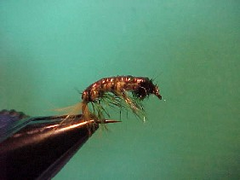
{{+1}}Scud{{-1}}
{{start}}
I use this fly to represent not only Scuds but also Olive Caddis Pupa which are of course a completely different types of creature. Scuds are true crustaceans of the family Isopod or Amphipods and generally you find them in shallow water in the detritus matter and around weed beds and drowned vegetation.{{end}}

{{+1}}Czech nymphs{{-1}}
{{start}}
The uncased caddis have quite a few similarities. They often adopt a curved fetal position and when they are free swimming they are more elongated still with a curved back but with a lifted head. The have short tail like filaments, have bodies of around seven or eight segments that may have abdominal gills at each segment, have darker heads with two or three segments and have 3 or more sets of legs below the head or toward the front of the grub.{{end}}
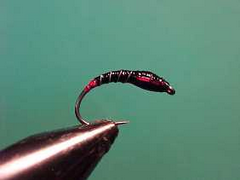
{{+1}}Black buzzer{{-1}}
{{start}}
When browns and rainbows are feeding on hatching midges at the exclusion of all else it pays to have a few buzzers in your kit. This pattern has proven itself to be readily accepted in many countries.{{end}}
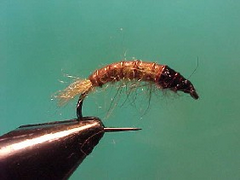
{{+1}}Foetal caddis grub{{-1}}
{{start}}
My preferred colours are light brown, light olive and hares ear each with slightly darker thoraxes and sand with a touch of orange or pink. All are tied with olive backs and heavily weighted so that they get down to where the fish are sitting.{{end}}
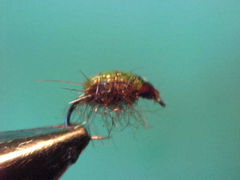
{{+1}}Snail – Chatto’s version{{-1}}
{{start}}
Snails are a food source for trout throughout the year. Having said that they are often overlooked by fly fishers. In colours imitating the naturals in the area to be fished they can be slowly twitched along the bottom or around the weed beds with great results. They are also a good ambush fly for trout foraging the margins. My standard choice of colours is a mottled brown and dark olive.{{end}}
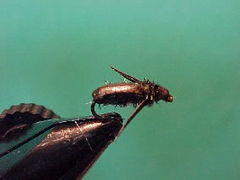
{{+1}}Corixia / back swimmer{{-1}}
{{start}}
Given the similarity of form and function both of these aquatic bugs can be represented by the following fly. This fly is best fished on a floating line that has been greased to within a meter of the fly or under a dry fly. It generally works well just sinking in the water column or moving naturally with the water current. If unnoticed try a couple of short figure of eight strips punctuated by a long pause to represent the natural swimming action of both bugs or a gentle lift to mimic "the natural" rising to the surface to breath.{{end}}
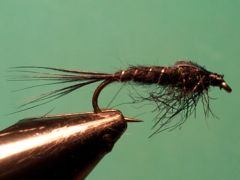
{{+1}}Flash back fuzzy nymph{{-1}}
{{start}}
In fast flowing water or where you just want your nymph to stand out a little a Flash Back nymph is an option. Whilst this nymph is not tied to represent the nymphal (sub imago or pupa) stage of any specific insect it is a good “buggy” looking fly and readily accepted by trout.{{end}}
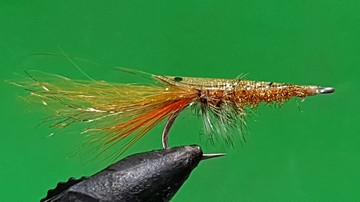
{{+1}}PET shell prawn{{-1}}
{{start}}
Prawns and shrimp are crustaceans, of the family Isopod, and are endemic to our Australian estuary waters. They are toward the top of the food chain for a lot of coastal species of fish including bream, flathead and whiting.{{end}}
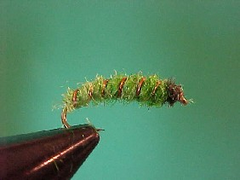
{{+1}}Caddis grubs{{-1}}
{{start}}
Most caddis grubs make a retreat of silk with sand or detritus matter stuck to the outside. Similar in form this fly represents a caddis grub that has been dislodged from it retreat. Colors include cream, lime, fawn, and light browns and olives through to dark browns and olives.{{end}}

{{+1}}Black & peacock{{-1}}
{{start}}
Flies that represent spiders and beetles are very buggy and suggestive flies. Weather being used as a polaroiding fly, a static wet, one of the flies in a team of loch style flies, or a fly to cover rising fish spider type soft hackle flies may be taken as a snail, submerged beetle, drowned terrestrial, diving beetle or even a carixia.{{end}}













